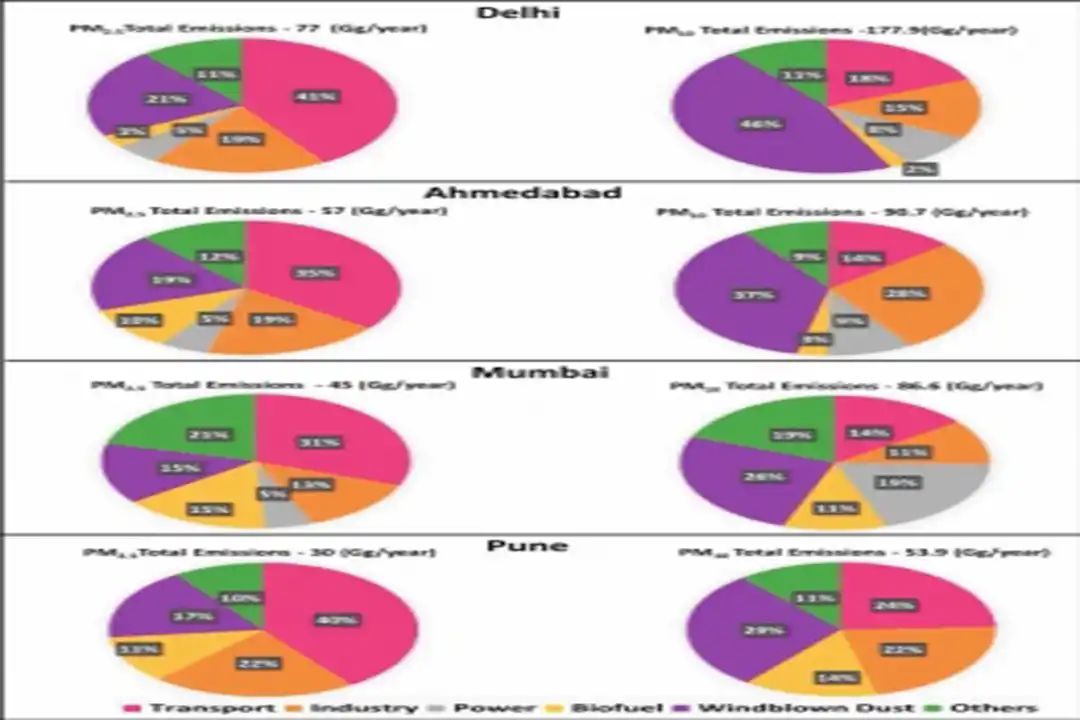Ahmedabad: On the basis of the System of Air Quality and Weather Forecasting And Research (SAFAR) framework, the new study is conducted and it pinpoints the total emissions of PM2.5 from all sources which is 77 gigagrams per year (Gg/Yr) for Delhi, 57 Gg/Yr for Ahmedabad, 45 Gg/Yr for Mumbai and 30 Gg/Yr for the Pune Metropolitan Region.
Urbanisation and high population density are the main, which directly or indirectly drives the PM2.5 emissions in all these four metropolises.
“The most dominating emission source of PM2.5 is transportation, whose share is found to be 41 per cent in Delhi, followed by 40 per cent in Pune, 35 per cent in Ahmedabad and 31 per cent in Mumbai,” the research paper titled ‘India’s maiden air quality forecasting framework for megacities of divergent environments: The SAFAR-project’ said.
The uncontrolled combustion pattern in the highly-dense slum population is significantly high in Mumbai, which is why the share of biofuel emissions is highest in Mumbai (15.5 per cent) followed by Pune (11.4 per cent), Ahmedabad (10.2 per cent) and significantly less in Delhi (3 per cent), said the findings from the first official, indigenous framework — the System of Air Quality and Weather Forecasting And Research (SAFAR) — published in a peer-reviewed international Elsevier Journal ‘Environmental Modelling and Software’ on September 15 and available online on Tuesday.
“Large number of PM2.5 hotspots are well scattered and can be identified in all cities due to the presence of industries. Industrial emissions were found to be highest in Mumbai (31.1 per cent), (21.6 per cent) in Pune followed by Ahmedabad (18.8 per cent) and Delhi (18.6 per cent),” it said.
The multi-author study was led by the Indian Institute of Tropical Meteorology (IITM-Pune) in association with the India Meteorological Department (IMD) and Utkal University, Bhubaneswar.
The findings are meant for citizens, decision-makers, and researchers as well and forecast the quality of air in four metros as mandated under the National Clean Air Programme (NCAP) which can provide a significant boost for air quality forecasting across other Indian cities.
Terming it as a “one-stop solution for air quality management leading up to mitigation,” SAFAR’s founder project director and lead author of the study, Dr Gufran Beig, said, the SAFAR framework can also help formulate micro specific air action plans based on robust science. “SAFAR’s forecasting model is comparable to the framework by the United States Environmental Protection Agency (US-EPA),” he claimed.
India has 132 non-attainment / million-plus cities under the NCAP programme, which seeks to achieve a 20 per cent to 30 per cent reduction in Particulate Matter (PM) concentrations by 2024 keeping 2017 as the base year. The non-attainment cities are those that do not meet the prescribed air quality standards set by the Union Environment Ministry.
SAFAR chose to demonstrate its forecasting model in four different and contrasting micro-climates of Indian cities- Delhi, Mumbai, Pune, and Ahmedabad. “Now, the prototype can be scaled up to the remaining 128 non-attainment cities of India as per the commitment to NCAP,” said Beig.
Six separate components make up the SAFAR framework, including Observational Network for Air Pollution and Weather Parameters, Quality Control and Quality Assurance, Inventory of Emissions: To keep track of pollution sources; SAFAR-Air Quality and Weather Forecasting Model; Data to Information Translation; The AQI Concept, & Technology; Outreach for Product Development, and Dissemination.
Beig noted that it was the vision of former Secretary of Ministry of Earth Sciences and now the Director, NIAS (IISc), Dr Shailesh Nayak, who foresaw its worthiness and conceived it 12 years ago when air quality issues have come to the centre stage only in recent years.



